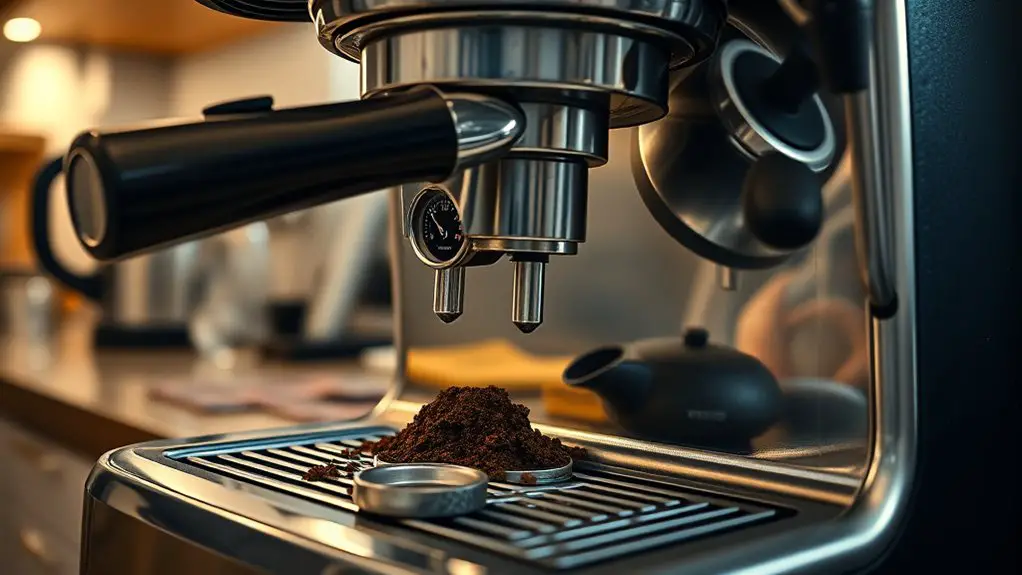If your Breville espresso machine isn't building pressure, several common issues could be to blame. Check your grind size; too coarse can result in weak extraction, while too fine can cause bitterness. Make sure you're tamping consistently with about 30 pounds of pressure. Clogged components or dirty filters can impede water flow, as can high mineral content in your water. Finally, regular maintenance is essential for peak performance. There's more to explore to resolve these issues effectively.
Incorrect Grind Size
When brewing espresso, if your grind size isn't just right, it can lead to pressure issues in your Breville espresso machine. The grind size must match the coffee bean selection; too coarse, and water flows too quickly, resulting in weak espresso extraction. Conversely, a grind that's too fine can create excessive resistance, preventing ideal pressure buildup and leading to bitter flavors. To achieve the perfect shot, carefully calibrate your grinder based on the type of beans used, as different varieties require different grind settings. Aim for a uniform grind to guarantee consistent extraction. Remember, the balance between grind size and coffee bean selection is vital for achieving that rich, full-bodied espresso you crave. Adjustments can transform your brewing experience. The recommended grind size position is 5 for optimal results.
Improper Tamping Technique
Achieving the right espresso extraction hinges not only on grind size but also on your tamping technique. If your tamping pressure isn't consistent or adequate, it can lead to poor pressure build-up during extraction. You should aim for approximately 30 pounds of tamping pressure; this guarantees even distribution and compaction of your coffee dosage. If you tamp too lightly, water will flow through the coffee too quickly, resulting in a weak shot. Conversely, excessive tamping can cause channeling, where water finds paths of least resistance, leading to uneven extraction. Pay close attention to your technique, as mastering tamping can greatly enhance your espresso quality, giving you the freedom to enjoy that perfect shot every time.
Clogged or Dirty Components
Even with perfect tamping, pressure issues can arise from clogged or dirty components within your Breville espresso machine. These obstructions can prevent water from flowing properly, leading to subpar brews.
To restore your machine's performance, check for:
- Clogged fittings that impede water flow
- Dirty filters that trap coffee oils and residue
- Accumulated scale in the water reservoir
- Blocked group heads that affect extraction
Regular maintenance is essential for ideal pressure. A clean machine not only enhances flavor but also extends the lifespan of your equipment. So, take a moment to inspect and clean these components. Your freedom to enjoy a perfect espresso deserves it! Additionally, perform routine checks to prevent clogged steam wand issues that can further disrupt pressure.
Water Supply Issues
If your Breville espresso machine isn't getting the right water supply, it can lead to significant pressure issues that affect your brew quality. First, check the water hardness; high mineral content can cause scaling, obstructing water flow and pressure. Use filtered or distilled water to maintain peak performance. Additionally, verify the supply temperature is within the ideal range of 195°F to 205°F. Water that's too cold won't extract flavors effectively, while excessively hot water can damage internal components. Regularly monitor these factors to guarantee your machine operates smoothly. Addressing water supply issues promptly not only enhances your espresso's flavor but also prolongs the lifespan of your machine, giving you the freedom to enjoy perfect brews consistently.
Machine Maintenance Neglect
Although it might seem minor, neglecting regular maintenance on your Breville espresso machine can lead to severe pressure issues that compromise the quality of your espresso. Without a proper routine cleaning and adherence to a maintenance schedule, you risk a cascade of problems that could rob you of your perfect brew.
Consider the consequences of neglect:
- Accumulated coffee oils that clog components
- Mineral buildup that disrupts water flow
- A dirty brew head leading to inconsistent extraction
- Shortened machine lifespan due to lack of care
- Regular cleaning prevents clogs and maintains performance of your machine.
Frequently Asked Questions
Can I Use Regular Coffee Instead of Espresso Beans?
You can use regular coffee, but it won't deliver those rich espresso flavors. Think of it like trying to paint a masterpiece with watercolors instead of oils—different coffee types yield distinct experiences. Stick to espresso beans for authenticity.
How Often Should I Descale My Breville Espresso Machine?
You should descale your Breville espresso machine every three to six months, depending on usage and water hardness. Regular descaling frequency helps maintain ideal performance; it's a key maintenance tip for prolonging your machine's lifespan.
Is It Safe to Use Filtered Water in My Espresso Machine?
Sure, using filtered water won't turn your espresso into liquid gold, but it does improve water quality. You'll enjoy the benefits of cleaner flavors and reduce mineral buildup—your machine will thank you, and so will your palate!
What Should I Do if My Espresso Tastes Bitter?
If your coffee tastes bitter, consider adjusting your coffee grind size; a coarser grind can reduce over-extraction. Also, explore bitter aftertaste solutions like adjusting water temperature or using fresher coffee beans for better flavor balance.
How Long Should My Espresso Shots Take to Brew?
Your espresso brewing times should typically range from 25 to 30 seconds. Aim for a shot extraction duration within this window to achieve ideal flavor and balance, ensuring a rich, satisfying experience in every cup.
